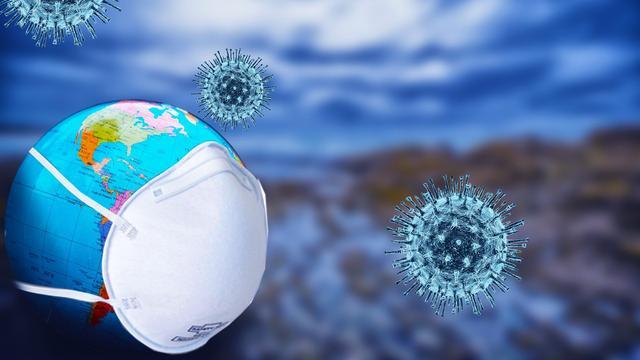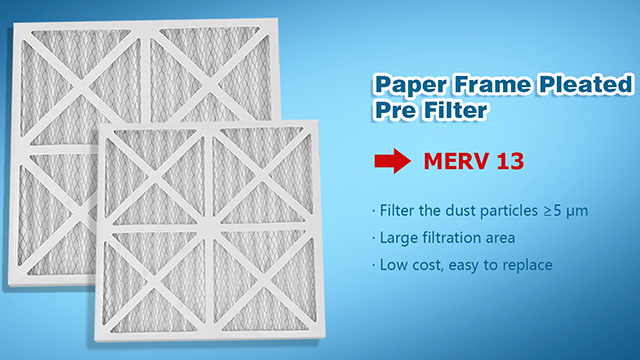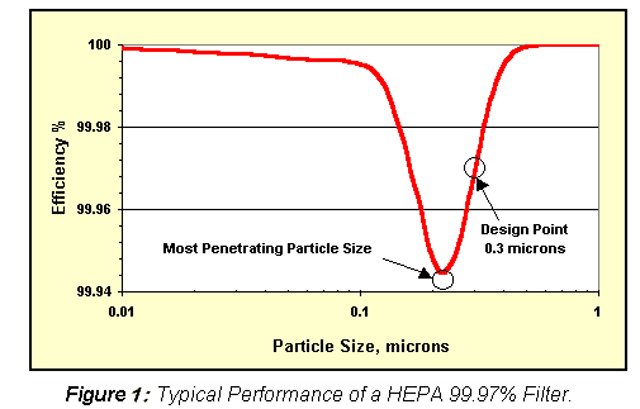2021年11月随着北半球冬季来临、气温不断下降,研究人员提示,新冠病毒的传播可能进一步恶化。大多数人都在寻求更好的办法来保护自己免受COVID-19的潜在性传播。世界卫生组织也警告说,当带有病毒的小飞沫悬浮在空气中时,就会发生更远距离的空气传播。因此市场上的许多空气过滤产品成为了许多大厦建筑与企业隔离空气中病毒传播的有效设施。
 |
许多健康安全组织指出,降低COVID-19风险的一个主要步骤是将建筑物的空气过滤器升级到 MERV 13 级或更高级别的空气过滤器;或在可能的情况下使用更高的 HEPA 等级。
那么什么是MERV和HEPA呢?他们有什么区别呢?
一、什么是 MERV 过滤器?
MERV 代表最低效率报告值,所有过滤器都有 MERV 等级,许多HVAC 公司和分销商提供的过滤器的 MERV 等级介于 1 到 20 之间。其中较大的数字表示较高的过滤效率和捕获更小的颗粒的能力,所以,过滤器的 MERV 等级越高,通过它的灰尘颗粒和其他污染物就越少。
下表总结了过滤器在 MERV 范围内的平均吸附量和应用,以及使用它们的典型粒径。
| MERV | 平均 逮捕 | 粒度范围 | 应用 |
| 1-4 | 60-80% | >10.0 微米 | 住宅楼 轻型商业建筑 设备保 |
| 5-8 | 80-95% | 3.0-10.0微米 | 工业工作场所 典型的商业建筑 更好的住宅建筑 喷漆房和整理 |
| 9-12 | >90-98% | 1.0-3.0微米 | 高级住宅楼 更好的工业工作场所 更好的商业建筑 医院实验室 |
| 13-16 | >95-99% | 0.30-1.0微米 | 除烟 医院住院护理 普通外科 高级商业建筑 |
过滤器的 MERV 是根据 ASHRAE 标准 52.2 通过实验室测试确定的。该测试使用 ASHRAE 指定的气溶胶发生器和合成粉尘,并在过滤器的上游和下游测量颗粒计数。MERV 评级的测试程序使用 6 次测量和 12 种粒径,从而产生总共 72 个数据点。
1、为了帮助防止建筑物中的冠状病毒感染,RT 建议将 HVAC 系统中的空气过滤器升级到至少 MERV 13。
 |
2、如果无法做到这一点,可以使用带有 MERV 13 或更好过滤器的便携式空气净化器。
3、在住宅环境中,RT 建议将典型的 1 英寸过滤器升级到 MERV 13,并将 2 英寸过滤器升级到 MERV 16。但是,在继续之前,您应该与 HVAC 工程师仔细检查。
4、当使用 UVGI 进行管道内空气清洁时,RT 建议至少使用 MERV 8 过滤来补充消毒系统。
过滤器仅在空气通过时有效。出于这个原因,RT 建议增加通风系统的运行时间表,如果可能,最多 24/7。更多的污染物和细菌被捕获,因为更多的空气通过过滤器。
二、什么是 HEPA 过滤器?
当谈到 HVAC 空气过滤器时,HEPA 过滤器通常被认为是最好的。高效微粒空气或 HEPA 具有比 MERV 16 更高的性能。
HEPA 代表高效微粒空气。HEPA 空气过滤器由数以千计的极细纤维组成,这些纤维排列成亚光以拦截微小颗粒和较大颗粒。空气净化器会将房间内的空气推入过滤器以去除污染物颗粒。根据定义,HEPA 过滤器可以捕获空气中接近 100% 的 0.3 微米或更小的颗粒。(请记住,一厘米有 10,000 微米,直径 0.3 微米的颗粒真的非常非常小。)
 |
HEPA 过滤器是空气净化器中常见的组件,它过滤空气以清洁空气——还有其他类型的空气净化器,如碳过滤器、离子发生器甚至非过滤器净化器。
鉴于其高效率,HEPA 过滤器还用于真空吸尘器和需要高空气质量的行业,例如航空航天、制药、核电和计算机芯片制造。
三、结 论
过滤是一种机械空气净化方法,这意味着它可以处理有生命和无生命的颗粒。HEPA 过滤器对于住宅或商业用途最有效,其次是 MERV 13-16 过滤器。然而,这些过滤器的气流限制会导致压力下降,在使用它们之前必须考虑通风系统的容量。
在通风系统无法处理高效过滤器的情况下,您可以使用便携式空气净化器,同时以现有容量升级到尽可能高的 MERV 等级。或者,您可以升级通风系统本身,使其至少适用于 MERV 13 过滤器。
暖通空调系统有多种类型,每栋建筑都是独一无二的。为了改善室内空气质量并防止 COVID-19 感染,最好的起点是由经验丰富的暖通空调工程公司进行检查。